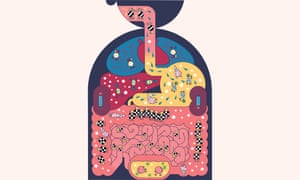reposted from the guardian

The human microbiome: why our microbes could be key to our health
A plethora of conditions, from obesity to anxiety, appear to be linked to the microbes inside us. Nicola Davis explains why the microbiome is such a hot topic of research
What are microbiomes?
Both inside and out, our bodies harbour a huge array of micro-organisms. While bacteria are the biggest players, we also host single-celled organisms known as archaea, as well as fungi, viruses and other microbes – including viruses that attack bacteria. Together these are dubbed the human microbiota. Your body’s microbiome is all the genes your microbiota contains, however colloquially the two terms are often used interchangeably.
Hang on, aren’t microbes supposed to be dangerous?
It’s a bit of a spectrum: some are pathogens, but others only become harmful if they get in the wrong place or boom in number, and some are very useful to the body – such as by helping to break down the array of sugars found in human breast milk. “These sugars are not broken down by the infant,” said Prof John Cryan, a neuropharmacologist and microbiome expert from University College Cork. Instead, microbes in the baby’s gut do the job.
Other key roles of our microbes include programming the immune system, providing nutrients for our cells and preventing colonisation by harmful bacteria and viruses.
Where do my gut microbes come from? Do I just pick them up from my surroundings?
Partly. But it is more complicated than that. “It is still a little bit controversial but for the most part it is thought that we are sterile when we are in utero, and as we are being born, as we emerge through the birth canal from our mums, we get this handover bacteria,” said Cryan. “It is like a gulp at birth. Those bacteria are really important for starting the whole process.”
Cryan notes that during pregnancy a mother’s microbiome shifts, apparently to an optimum mix for offspring. “If you are not born by vaginal delivery, but are born by [caesarean] section, things start off being different,” he said. Indeed, studies have suggested that these differences could be one of the reasons why babies born by caesarean section have a higher risk of conditions including asthma and type 1 diabetes. That said, doctors have cautioned parents against attempting to seed babies born by caesarean section with vaginal bacteria.
Our gut microbiome changes quickly over our first year or two, shaped by microbes in breast milk, the environment and other factors, and stabilises by the time we are about three years old. But our environment, our long-term diet, stress and the drugs we take, such as antibiotics, continue to play a role as we age, meaning our microbiome can change throughout our life.
It seems like microbes are everywhere – how many are we talking about?
The figure that has been bandied out since the 1970s is that microbes outnumber our own cells by about 10 to one. But a study from 2016 suggests that in fact microbial cells and human cells coexist in somewhere around a 1.3 to one ratio – suggesting they only slightly outnumber our own cells, although that doesn’t count viruses and viral particles.
Does this mean I am not human?
Some say we should be seen as a holobiont, a term that reflects the intimate, co-dependent relationship humans have with microbes. “I tell this joke that the next time someone goes to the bathroom and they get rid of some of their microbes they are becoming more human,” said Cryan.
But Ellen Clarke, a philosopher of biology at the University of Leeds, is not convinced. “It all depends on what you mean by ‘human’ in the first place,” she said. “If you think that a human is a collection of cells that all share copies of the same chromosomes, then it is shocking to be told that our bodies contain cells with bacterial DNA.”
But as Clarke points out, human cells don’t just contain chromosomes, but also carry DNA within our cellular powerhouses, mitochondria, which are evolutionary descendants of bacteria. Our genome also contains stretches of genetic material called transposons that, at least in some cases, are thought to have been introduced long ago by viruses. “I prefer to define a human in evolutionary terms, and if we do this then mitochondria are parts of a human, and so are transposons, but gut microbes are not, and neither are prosthetic limbs nor unborn foetuses,” said Clarke, pointing out that microbes can escape the body and live without us.
Are microbes the same in my gut as on my skin?
No, different parts of the body – the skin, vagina, gut – all have very different, distinct communities of microbes. While gut microbes have gained a lot of attention, microbes elsewhere are also important: in recent studies, scientists have found that bacteria commonly found on the skin might help to protect against skin cancer.
Microbiomes also differ from person to person. “When you look at the overall active microbiomes between two healthy people, even if they are living in the same city, you see a tremendous amount of disagreement in their microbiome,” said Rob Knight, professor of paediatrics, computer science and engineering at the University of California San Diego and an expert on the human microbiome.
Variability in the gut microbiome, Knight notes, helps to explain why people respond differently to the same foods. “Whether tomatoes are good or bad for you, whether rice is good for you or worse for you than ice cream and so on is explained by your microbiome,” he said.
Why has the microbiome become such a hot topic for research?
Over recent years the gut microbiome in particular has been linked to a plethora of diseases and conditions, from diabetes to autism and anxiety to obesity.
The gut microbiome has also been linked to how individuals respond to certain drugs, including how cancer patients respond to chemotherapy, and it has even, tentatively, been suggested that it could be linked with how well we sleep.
Meanwhile, a range of studies have raised the importance of other aspects of our microbiome, including that the vaginal microbiome is important in whether an HIV-prevention drug applied to the vagina is effective.
Why do we think the microbiome is linked to all these conditions?
While some links have come from comparing the microbiomes of different groups of people, such as those with a particular disease compared with healthy individuals, a big player in microbiome research is the germ-free mouse.
This organism is raised in a sterile environment and can then be exposed to particular microbes, or groups of microbes, to explore their impact. Such studies have been key in raising possible links between the gut microbiome and numerous aspects of our health, including mood and obesity.
Is it that particular microbes are important, or is it about the microbial community as a whole?
This is the knotty issue. In some experiments, particular strains of bacteria have been linked to particular effects or conditions, while others have shown that the diversity of the microbiome, or relative abundances of species, is important.
“It is a bit like a rainforest: you might have a very nice fern that is very happy but if that is the only thing in your rainforest and you don’t have a diversity it is not going to be good [for the] soil,” said Tim Spector, professor of genetic epidemiology at King’s College London and author of The Diet Myth. When it comes to the microbiome, “it’s having the right community of bacteria that are working together and together producing the right chemicals for your body.”
So might microbes be affecting our weight, or even our brains? That sounds a bit sci-fi.
When it comes to obesity, there are several ways gut microbes might influence matters, including through appetite, production of gases, efficiency of using food, and impact on the immune system and inflammation.
When it comes to affecting mood, there are also several mechanisms. One is via the vagus nerve, a two-way highway that runs from our brain to various organs in the body, including the gut.
With the microbiome linked to so many conditions, does tinkering with it promise a whole range of new treatments?
It is worth being cautious: many studies show associations rather than cause and effect, and some are based only on studies in germ-free mice and have not been explored in humans. Even in mice things aren’t straightforward – effects are not always the same for both sexes and can differ for different strains of mice.
And there are other factors to consider: “For obesity what it looks like is in different human populations, different kinds of microbes are involved in the differences between lean and obese humans,” said Knight.
Spector said: “I think everyone is right to be sceptical, and a lot of the links may just be that [microbes] are not necessarily the cause of [a disease], but they might be a secondary effect of it.”
Others say it isn’t surprising that our microbiome might be closely linked to our health. “All of human development and all the systems in the body have all evolved, or co-evolved, with our microbes,” said Cryan. “As humans we are very much human-focused and we feel that human cells and genes have primacy, but the microbes were there first.”
Does any of this actually affect patients?
Up to a point. The field has already led to advances in the treatment of C difficile – an infection that causes serious diarrhoea and can prove deadly. Patients can now receive faecal transplants from a donor with a healthy microbiome to “reset” their inner community – a procedure that has been shown to rapidly cure the condition.
Some researchers, including Cryan, believe microbiome research could lead to the development of new mental health therapies. “We have coined the term ‘psychobiotic’ [by which we mean] a targeted intervention of the microbiome for brain health,” he said.
While that may be some way off, Cryan believes it will become routine for doctors to keep an eye on the makeup of patients’ microbiomes. “I think personally that bacteria- or microbiome-derived medicine is the future of precision medicine,” he said.
Let’s cut to the chase: what can I do to keep my microbiome in good shape?
This is where prebiotics and probiotics come in: the former are substances, such as the fibre inulin, on which useful microbes can thrive, while the latter are microbes themselves that are thought to be beneficial for health, such as the Lactobacillus and Bifidobacterium species.
While both prebiotics and probiotics can be taken as supplements, whether you should shell out for them is another matter: there is little advice on which prebiotics or probiotics people should consume for a particular situation, and when it comes to probiotics it isn’t a dead cert that the microbes will colonise your gut when they get there, or if they will offer benefits to already healthy people, such as preventing diseases. That said, if you are taking antibiotics or have IBS, there is some evidence probiotics might be a good idea.
“It is not clear yet whether you’re better off just having lots of yoghurt and other fermented foods or actually taking these formulations,” said Spector, adding that in general he recommends opting for tweaking your diet to get a dose of probiotics, since it isn’t clear which strains individuals should take. The same goes for prebiotics: “there is more variety in food in terms of the fibre, therefore more variety in the microbes,” he said. “Ideally you combine a prebiotic and a probiotic: something like sauerkraut or kimchi.”
What next?
The spotlight is on unpicking the mechanisms by which microbes are linked to human health. Among the conundrums is how and why the different strains of bacteria have different effects, while researchers are also developing studies to explore how the microbiome influences our response to food, and how different diets can tweak the microbiome. There is also a need to take more of the exciting findings from mouse studies and probe them in humans, preferably through randomised control trials.
Further reading:
I Contain Multitudes, by Ed Yong
Gut: The Inside Story of Our Body’s Most Underrated Organ, by Giulia Enders
The Psychobiotic Revolution, by Scott C Anderson with John Cryan and Ted Dinan
Follow Your Gut: How the Ecosystem in Your Gut Determines Your Health, Mood, and More, by Rob Knight
Illustrations: Pete Gamlen


No comments:
Post a Comment